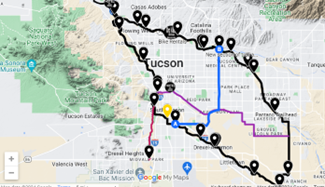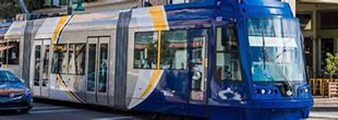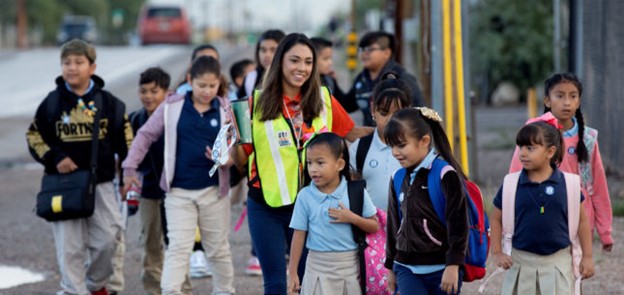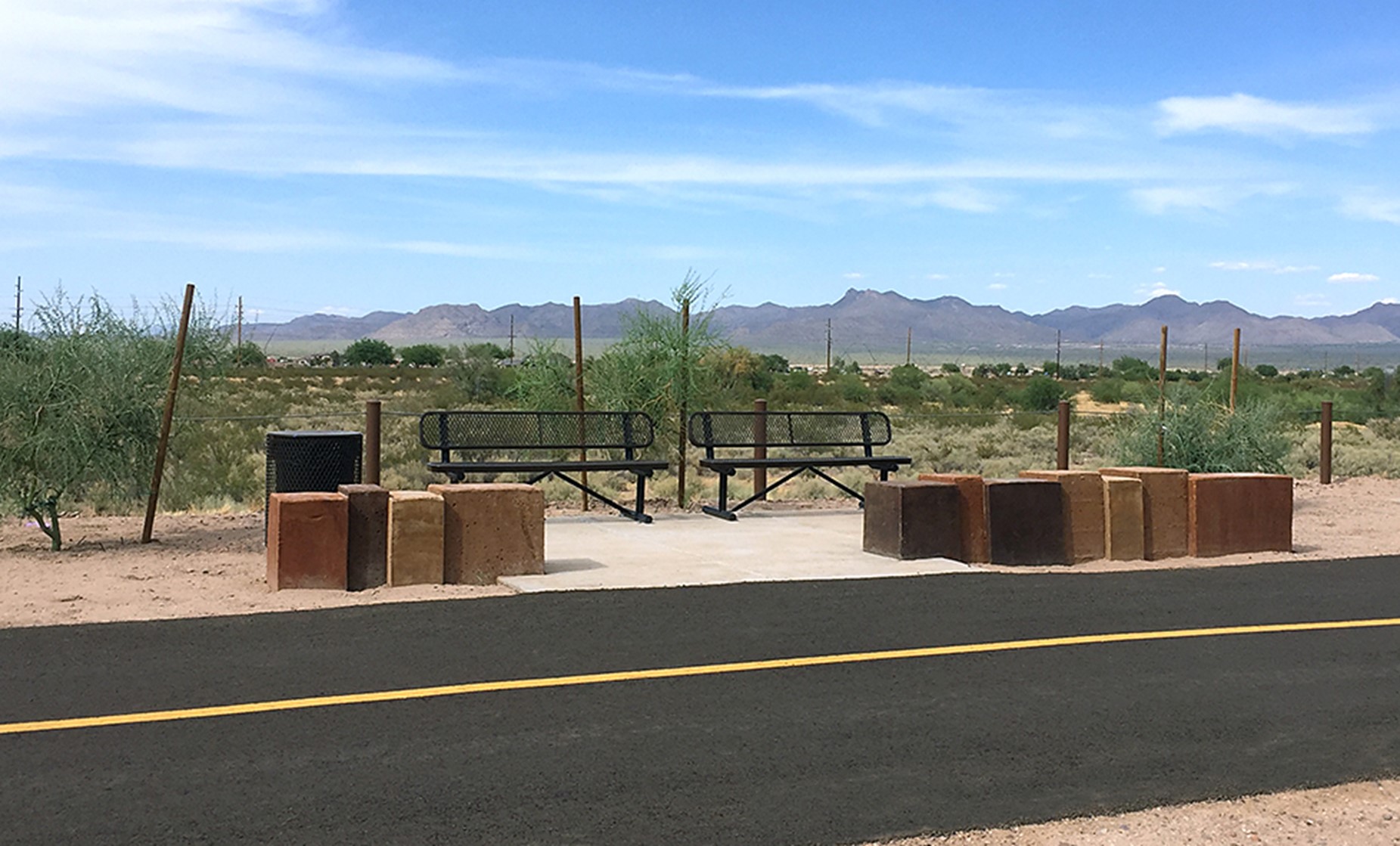By: Jeff Stine, PE and James Beier, PE, PTOE, RSP1
In recent years, Pima County, including Tucson, Oro Valley, Sahuarita, and others, have embarked on transformative journeys to enhance pedestrian and bike access as part of their commitment to multi-modal transportation solutions. These initiatives aim to create sustainable, accessible, and healthier communities by offering alternatives to car-centric infrastructure.
The Imperative for Multi-Modal Transportation
As urban areas expand, they face challenges such as traffic congestion, pollution, and road safety. Multi-modal transportation, which integrates various forms of transit, including walking and cycling, into the urban landscape, offers a viable solution. By reducing car reliance, these communities can lower greenhouse gas emissions and promote a cleaner environment. Additionally, increasing physical activity through walking and biking leads to better public health outcomes.
The Role of PAG and RTA:
The Pima Association of Governments (PAG) and the Regional Transportation Authority (RTA) have been pivotal in transforming the transportation landscape in Pima County. Through strategic planning, collaboration, and effective use of a voter-approved funding mechanism, PAG has significantly improved multimodal transportation across the region. In 2006, Pima County voters approved a half cent sales tax dedicated to funding transportation projects. Managed by the RTA, this funding mechanism is set to last for 20 years, generating substantial financial resources earmarked for various transportation improvements. The steady stream of funding ensures that projects can be planned and executed without the uncertainty of fluctuating financial support.
Expansion of Multimodal Infrastructure
The “Loop”
A major focus of PAG and RTA’s efforts has been the expansion of multimodal transportation options. “The Loop” is a network of shared-use paths spanning over 131 miles. This extensive system connects parks, schools, and neighborhoods throughout the region, providing safe routes for cyclists, pedestrians, and other non-motorized users.

Streetcars
The Sun Link streetcar system, which runs through downtown Tucson, the University of Arizona, and the Mercado District, is a significant public transit enhancement. This project has improved connectivity and provided a reliable and efficient transit option for residents and visitors.

Safe Routes to School
The Safe Routes to School program enhances safety for children walking or biking to school. This initiative focuses on infrastructure improvements such as better crosswalks and signage, creating a safer environment for students. Across Arizona, 27 Safe Routes to School projects have been implemented, ranging from easy start-up programs to significant infrastructure upgrades, all aimed at encouraging children of all ages to adopt walking or biking as part of a healthy lifestyle.
In addition, ADOT’s Safe Routes program has awarded reimbursement grants to support the “Walking School Bus” project. This innovative program involves students and parent volunteers meeting at a designated location to walk to school together. The grants cover the costs of a Walking School Bus coordinator and stipends for volunteers, ensuring the program runs smoothly and safely.

What’s Next?
Looking ahead, PAG and RTA continue to explore innovative solutions to further enhance multimodal transportation in Pima County. Plans to expand the network of bike lanes, pedestrian paths, and public transit services are underway, aimed at creating a fully connected and sustainable transportation system. The incorporation of smart city technologies, such as real-time traffic monitoring and adaptive signal control, is expected to further improve the efficiency and safety of the region’s transportation infrastructure.
Here are some key future-focused initiatives:
2055 Regional Mobility and Accessibility Plan (RMAP):
- PAG is developing the 2055 RMAP, which is a comprehensive long-term transportation plan. This plan is intended to guide regional transportation investments for the next 30 years. It includes projects related to roadway improvements, transit, active transportation, and environmental considerations. Member jurisdictions, including the cities of Tucson and South Tucson, towns of Marana, Oro Valley, and Sahuarita, Pima County, the Pascua Yaqui Tribe, and the Tohono O’odham Nation, are involved in this planning process.
Next 20-Year Regional Transportation Plan:
- The RTA is preparing a new 20-year regional transportation plan with a budget of $2.34 billion. This plan will be presented to Pima County voters before June 2026 and will include a continuation of the existing half-cent sales tax. The plan’s development involves significant public outreach to gather input on priorities and projects, ensuring it aligns with regional needs. The draft plan includes multimodal roadway corridors, transit improvements, safety enhancements, active transportation infrastructure, and environmental projects.
Long-Range Regional Transit Plan:
- PAG’s Long-Range Regional Transit Plan focuses on enhancing public transportation with a “frequency first” approach. It aims to improve the frequent transit network, provide more evening and weekend services, and target suburban transit routes for enhancements. The plan also includes infrastructure improvements to support speed, reliability, and service quality of the transit system. This plan was developed with extensive public input and collaboration with member jurisdictions.
These initiatives reflect PAG and RTA’s commitment to improving transportation infrastructure, enhancing mobility, and supporting sustainable development in the region.
| Case Study: Town of Marana Santa Cruz River Shared-Use Path
The Town of Marana Santa Cruz River Shared-Use Path project aims to enhance the community’s recreational and transportation infrastructure by providing a 2.7-mile shared-use path along the Santa Cruz River. This path offers scenic views and a natural setting for various users, including pedestrians, cyclists, and other non-motorized modes of transportation. Designed to create a safe and accessible route, the path includes amenities such as benches, signage, and lighting to enhance usability and safety. It caters to both recreational and commuter needs, promoting healthier lifestyles and alternative transportation options. The environmentally sensitive design preserves the natural beauty of the Santa Cruz River area. The asphalt path is part of the Town of Marana’s multi-modal transportation plan, allowing users to enjoy the river’s habitat and scenery. Positioned along the scenic corridor of the Santa Cruz River, it preserves the natural environment for wildlife. Trees, shrubs, and accent plants were selected to blend seamlessly with native vegetation, providing shaded areas for joggers, walkers, cyclists, and equestrian riders. EPS Group collaborated closely with the Town of Marana to establish a viable landscape and irrigation plan that remained within the project budget. The path offers panoramic views of the Tortolita Mountains and “Sombrero Peak” in the Tucson Mountains. Users can enjoy excellent bird-watching, aquatic life, and various plants along the river’s edge. The Santa Cruz River offers sights and sounds ranging from calm waters to mild rapids. This shared-use path provides an excellent opportunity to exercise outdoors while experiencing the views, flora, fauna, and history of Marana. The path meanders through both the northern and southern parts of town, parallel to the Santa Cruz River. It allows users to travel a portion of the 1,200-mile route followed by Juan Bautista de Anza in 1775-76, when he led over 240 people on an overland journey from New Spain to Alta California. The 9.65 miles of paved path offer suitable surfaces for walking, running, biking, and horseback riding. Amenities include drinking fountains, benches, garden areas, and dog waste stations.
EPS Group played a crucial role in the project’s success by:
|
EPS Group: Your Partner in Multi-Modal Transportation Solutions
At EPS Group, we elevate Arizona’s public works departments. Since 2003, we have been a trusted industry leader, committed to improving the communities we serve. With over 300 professionals, we excel in multi-disciplinary land and infrastructure development, making us a reliable choice for high-quality public works projects.
Choosing EPS Group means partnering with a firm that puts people first, ensuring your public works initiatives succeed. We offer integrated and efficient solutions for complex projects, understanding the unique challenges of Arizona’s rapidly growing counties and municipalities.
For public agencies across Arizona, this means meeting deadlines, managing budgets, and achieving project success. Together, we can make a lasting impact on Arizona’s public works landscape.
EPS Group is known for delivering innovative multi-modal transportation solutions. We specialize in pedestrian and bike infrastructure. Our portfolio includes successful projects that improve urban pedestrian and bike access, offering comprehensive services from planning and design to construction management.
Our approach involves engaging local residents and stakeholders through public meetings, surveys, and workshops, ensuring outcomes reflect community needs. We incorporate the latest technologies and sustainable practices into our designs, prioritizing safety with features like dedicated bike lanes, improved lighting, and traffic calming measures.
If you’re a public service professional, we salute you. No public agency is immune to aging infrastructure, rising costs, or limited resources. As your engineering partner, we help you do more with less, offering efficiency through a multi-discipline, Arizona-based team that understands local nuances.
————————————————
Jeff Stine, PE is a Senior Project Manager at EPS. Jeff has been the Principal Civil Engineer at EPS since its opening in 2005 and has completed more than 200 projects over the past 18 years at EPS Group. Connect with me – Jeff Stine | LinkedIn.
James Beier, PE is a Traffic Engineer at EPS. James has more than 19 years of experience in transportation engineering and is a Level 1 Road Safety Professional (RSP1). Connect with me – James Beier, PE, PTOE, RSP1 | LinkedIn.
———————————————–


